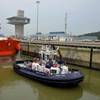The Panama Canal Authority (ACP) held a public hearing giving Canal customers and other interested parties the opportunity to comment on the modified pricing structure proposed by the ACP in early June of this year. Nearly fifty interested persons presented comments, with many expressing their appreciation for the recent improvements in safety and efficiency of Canal operations, but also saying that the percentage increase is too high and poorly timed.
Subsequent to the hearing, the ACP will study the comments, as it considers the proposed changes in rates and pricing structure. If approved, the new pricing structure is anticipated to go into effect in October, 2002.
The hearing was a significant step in the consultation process initiated by the ACP several weeks ago. Forty-six participants - composed of representatives from shipping companies, associations, governments and private citizens - participated today. The ACP will now assess all suggestions and make a final recommendation for approval by the Canal Board of Directors and Panama’s Cabinet Council.
“Today is a great day for the Canal, Panama and the democratic process. Clearly some of our customers have concerns but they also recognize the excellent job we have done to make transits through the Canal safer and faster. Changing our pricing structure will provide a strong foundation for future Canal improvements, and guarantee fast, safe and efficient transit. Now more than ever, the ACP is going to provide our customers with what they need,” said ACP Administrator Alberto Alemán Zubieta.
The Proposed New Pricing Structure
In June of this year, the ACP formally proposed changes to the waterway’s pricing structure. Designed to provide better and more efficient service to its customers, the ACP is transforming the business model of the Canal towards a market-oriented business system - one that takes into consideration the value of the Canal route.
“As the growth of world trade continues, the shipping industry has evolved significantly and the Canal’s pricing structure, which has remained unchanged for 90 years, must adapt to meet the growing demands of a dynamic market place,” said Administrator Alemán Zubieta.
“This historic shift in the ACP’s business model is the first step toward changing the long-standing one-size-fits-all pricing structure and replacing it with a system that is more tailored to the individual needs of our clients,” the Administrator continued. “A change in the pricing structure to a market-oriented system is needed to better serve the evolving needs of Canal customers.”
Under the new pricing structure, average Canal tolls will increase by 13 percent, with a per wire fee for the use of locomotives.
“The Panama Canal is still the best deal in the world for customers we serve,” said Alemán Zubieta. “This price change is reasonable and fair for all and will have minimal impact on trade and our users. The increase amounts to less than two percent of the total transportation costs for goods transported through the Canal.”
Under the proposal:
Prices will continue to be set using the same Panama Canal measurement system established in Panama Canal Operations Maritime Regulations for the calculation of the vessels’ total volumetric capacity. PC/UMS tons will continue to be the basis for toll charging.
All vessels will pay for the ancillary services they require, including the use of locomotives, line handlers, and additional pilots.
The pricing structure will continue to be the same for all vessels transiting the Canal, regardless of the type of cargo or their point of origin or destiny.
The proposal establishes the segmentation of vessels according to recognized industry standards: container ships, passenger ships, general cargo ships, dry bulk carriers, liquid bulk carriers, reefers, and vehicle carriers. Market studies for each segment are already being conducted.
The new pricing structure is consistent with the principles of international law and the practices of other international waterways, such as the Suez Canal.
Subscribe for
Maritime Reporter E-News
Maritime Reporter E-News is the maritime industry's largest circulation and most authoritative ENews Service, delivered to your Email five times per week










